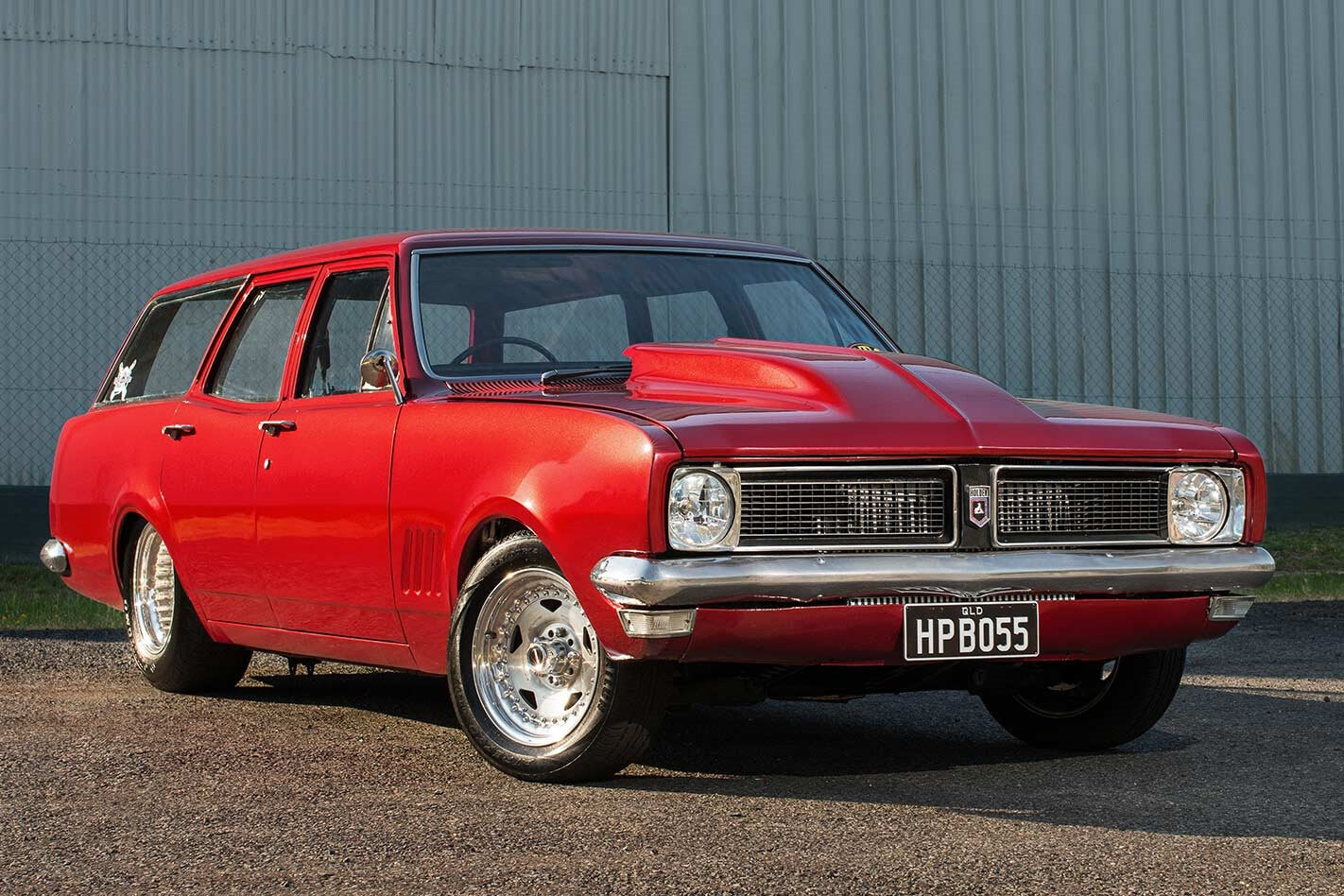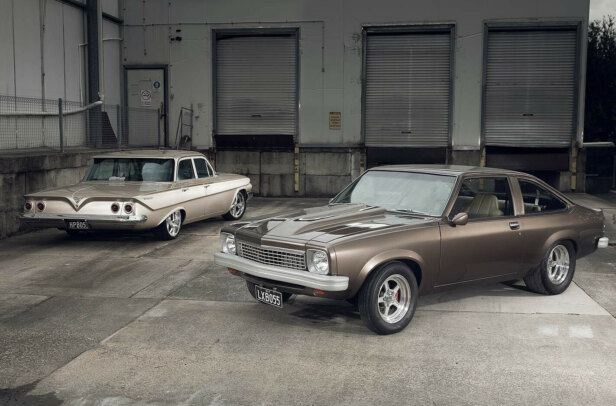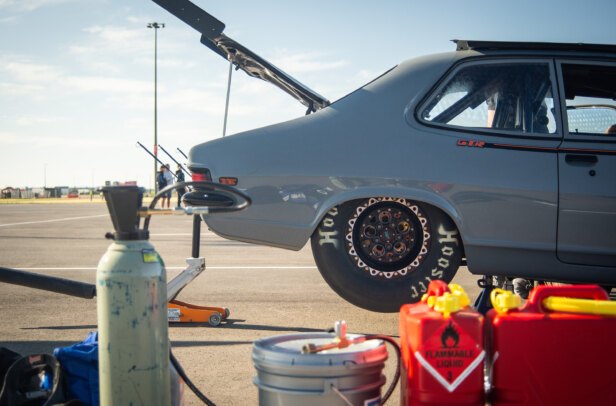This article on Mark’s Kingswood wagon was originally published in issue #6 of Street Machine’s LSX Tuner magazine, 2017
IF YOU’VE got a copy of the first issue of LSX Tuner you might recall Mark Tralau’s name, as we featured his killer 383ci ’61 Chev sedan and stock-bottom-end LX Torana hatch. Both cars packed turbocharged Gen III LS1s, and the Queensland-based mechanic built them at home in his garage. However, soon after that issue came out he sold the gold Torana and went looking for a more family-friendly package.
While Mark’s other cars have all had fresh panel and paint work, he was after something more survivor than show car this time around. “I wanted a wagon, but I didn’t originally want something this tidy. Still, this car popped up and these days you’ve only got an hour to make your mind up before it sells
What he’s ended up with is a mint 1970 HG Kingswood station wagon packing a twin-turbo 5.3-litre LS that looks set to run low nines, but will also cruise happily to and from the track, all on leaf springs and, once again, built in his home garage.
Street machining is a family affair in the Tralau house, as Mark explains: “I love being able to drop my kids Tyson and Lincoln at school in this car. I wanted something my wife could drive, or that I could give to my mates to take out. I love taking the kids to Lakeside in this thing!”
“I was keen on building a cool longroof wagon street car when this HG popped up on Facebook for sale as a roller,” Mark explains. “It was in Toowoomba so I took a mate and a trailer, and went and picked it up.”
I love the grumpy old-school big- and small-block sound, but with the amount of negative attention the car scene gets today I don’t want to add to that!”
Fitting an LS engine to an HK-HG Holden is nowhere near as simple as later-model Holdens, thanks to the stock crossmember and steering set-up, which puts the drag link, tie-rods and idler arm right in the way of the sump. While there are steering rack conversions on the market, Mark chose to work his oil pan around the factory linkages by cutting up a VE Commodore sump, which also let him keep the oil filter in the stock spot on the motor for a cleaner installation.
The alloy 5.3 L33 has been stretched to just under 6.0 litres thanks to a Scat crank, Compstar conrods and Wiseco pistons, with a custom-grind cam. A pair of cathedral-port 799 heads live up top, given a bit of work to tidy up the castings as well as having Comp pushrods and Lunati valves and springs fitted.
They’re a classic wheel on street machines and Mark was lucky enough to score the HG already wearing the Convo Pros, measuring 15×5 up front and 15×10 ot back. No factory first-generation Kingswood rear end would swallow meats that big, so the car’s been mini-tubbed to the rails for clearance
“I actually bought some of the engine in bits – block, rods, crank and pistons – from WA, and I then found the car,” Mark says. “Once I had the car home I started collecting bits and pieces to put it together. The alloy 5.3 is still nice and light but has a thick wall so it will handle the boost. It popped up and was a good deal. To actually build a motor from scratch, it would be much more expensive – it was too cheap not to buy!”
The 799 heads are the same casting as the highly desirable 243 heads found on the LS2 and LS6, and feature the same-size valves, albeit not the lightweight sodium-filled ones found on the LS6. The 799 head castings can be harder to find, however, only being in production since 2007 on certain truck models
To keep detonation at bay, twin in-tank fuel pumps have been fitted to the wagon tank, while a MegaSquirt 3 Gold Box ECU runs the show. Unlike earlier MegaSquirt computers that had to be pieced together by the owner, the MS3 Gold actually comes with a plug ’n’ play loom for LS motors.
Mark tends to be responsible for almost every part of his own cars, and that custom intake manifold is no different. Even though he’d never made one before, he broke out the TIG and used some rudimentary measurements to construct the tall runners and large plenum.
“I pride myself on building the car by myself, at home in my garage, so I set the suspension up, built the engine, transmission and diff, plus I fabricated the engine and transmission mounts, as well as the hidden turbocharger and intercooler set-ups, and intake manifold.”
One major point of difference with the HG’s build over previous LS set-ups Mark has done was the choice to go twin turbos instead of one oversized unit. The 76mm units are actually mounted out of sight behind the front guard on a pair of custom headers that Mark made at home to hide the whole system, including the front-mount intercooler piping. From there, spent gasses are pushed down a twin three-inch exhaust system.
“I wanted to have the engine bay more symmetrical than my previous single-turbo cars, but then I decided to have more of it hidden so it looked like more of an engine bay,” Mark says. “I try to do things differently – just like the Chev and the other cars I’ve built.
“From day one, it’s all capable of doing 1000rwhp all day long, street and track. To do that safely in a street car I really needed an intercooler. I’ve set this car up so I can switch it to methanol, but I’m pretty lazy and I’d rather drive there and run a time.”
To keep the engine bay neat as a pin, Mark also removed the stock bonnet release cable, tucked the wiper motor inside the cabin, fitted an alloy radiator and AU Falcon thermo fans, then got to welding and smoothing unused holes before Jamie Schloss squirted fresh burgundy over the bay.
Mark fitted an HR steering wheel and, instead of a bank of Auto Meters, runs a tablet to view all the important engine info.
Gears are banged in a three-speed TH400 ’box, manualised and equipped with a JW Ultra Bell housing, PTC converter and transbrake, which Mark put together at home. The tailshaft is a heavy-duty 3.5-inch chrome-moly unit equipped with 1350 unis, which should be able to handle all the angry small-block can dish out even once Mark bolts slicks to the rear end.
“I use a Raspberry Pi 3 tablet, which is like a mini-computer,” he says. “I can tune the engine and run the gauges through it. If something is out of its parameter the lights flash and illuminate in a different colour. It was a couple of hundred bucks for that and I don’t have to run multiple different gauges”
Sitting on a pair of leaf springs, the diff is a nine-inch that Mark braced to stop it twisting once the force-fed LS starts putting the hurt on. He also kitted it out with a Strange centre, 35-spline axles and heavy-duty yoke, so he’s never left stranded on the startline.
“So far I’ve only done one test launch and, off the foot brake, it did a 1.5sec 60-foot, trapping at 12.3 at 61mph,” Mark laughs. “I’m aiming for low nines at over 145mph.”
While that may keep regular punters focussed, Mark is also eyeing off his ’61 Chev and has made murmurs about an angry big-block for that. One thing’s for sure, he will never be bored!
MARK TRALAU
1970 HOLDEN HG KINGSWOOD
Paint Burgundy two-pack
ENGINE
Type: L33 alloy 5.3L
Capacity: 363ci
Pistons: Wiseco
Crank: Scat
Rods: Compstar
Intake: Custom-made
Turbos: Twin 76mm
ECU: MegaSquirt 3
Injectors: 2200cc
TRANSMISSION
Gearbox: TH400, manualised with transbrake
Converter: PTC
Diff: 9in, 35-spline axles, Strange centre, billet yoke
SUSPENSION & BRAKES
Springs: Stock (f); Custom, CalTracs bars (r)
Shocks: Stock (f), Competition Engineering (r)
Brakes: HQ discs (f), Strange drums (r)
WHEELS & TYRES
Wheels: Convo Pro; 15×5 (f), 15×10 (r)
Tyres: 195/60 (f), 255/60 (r)




Comments